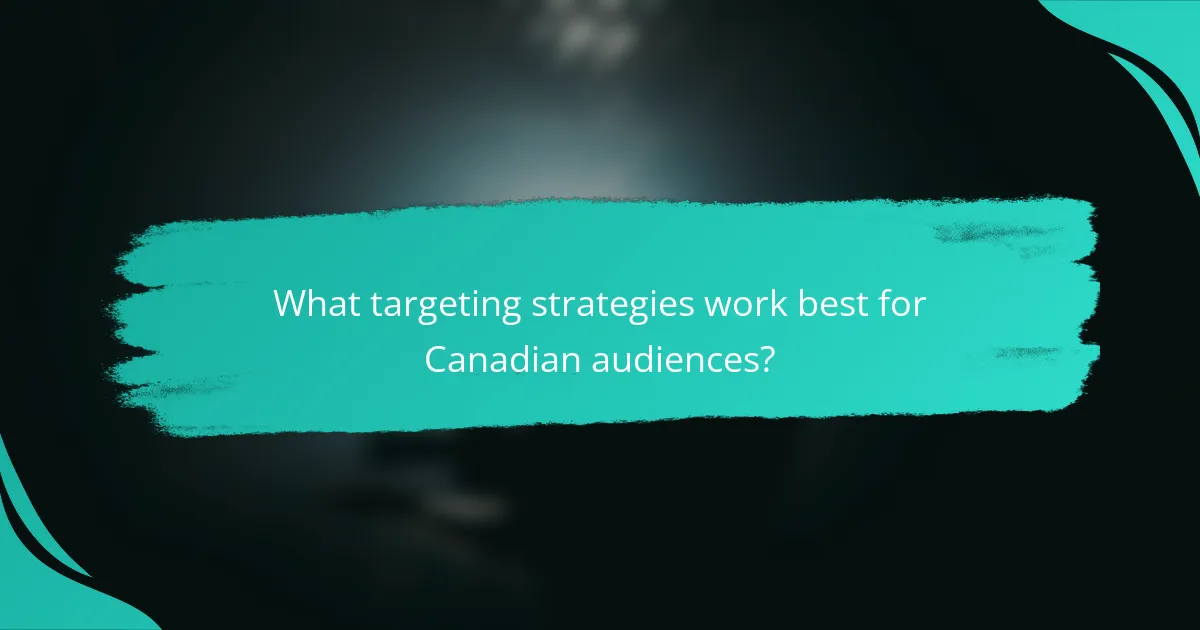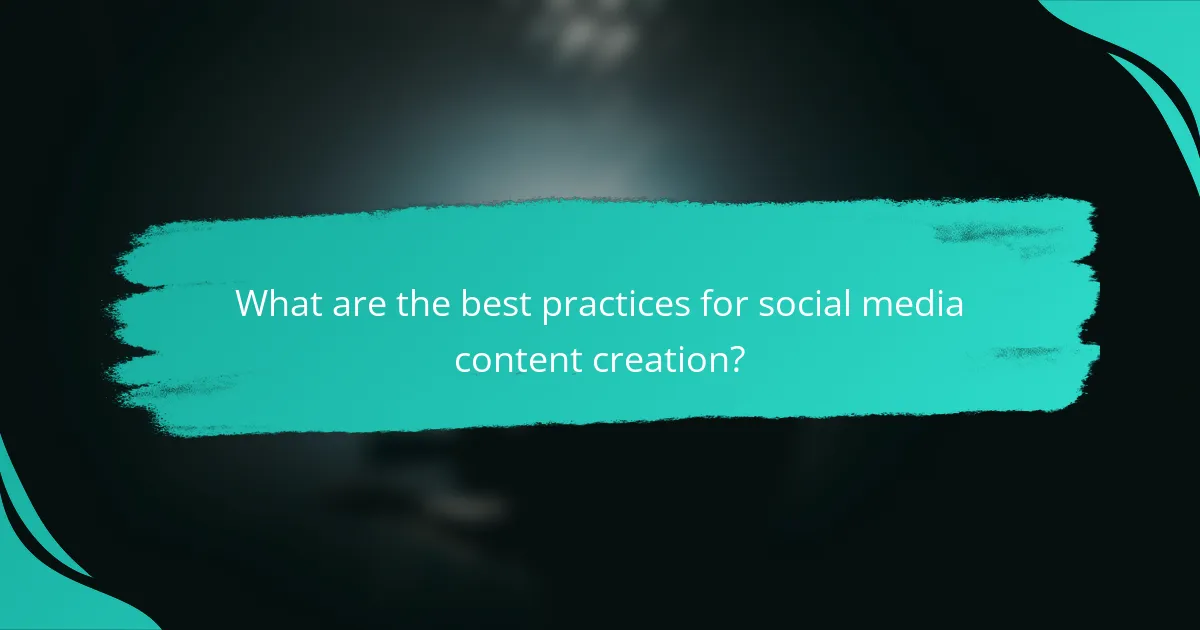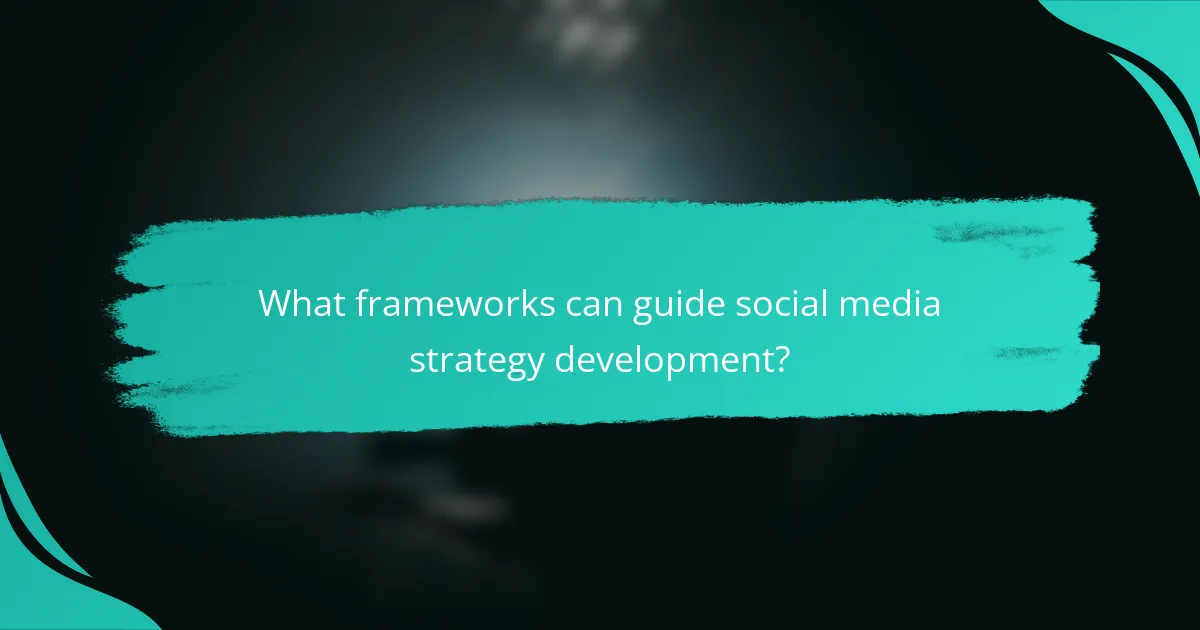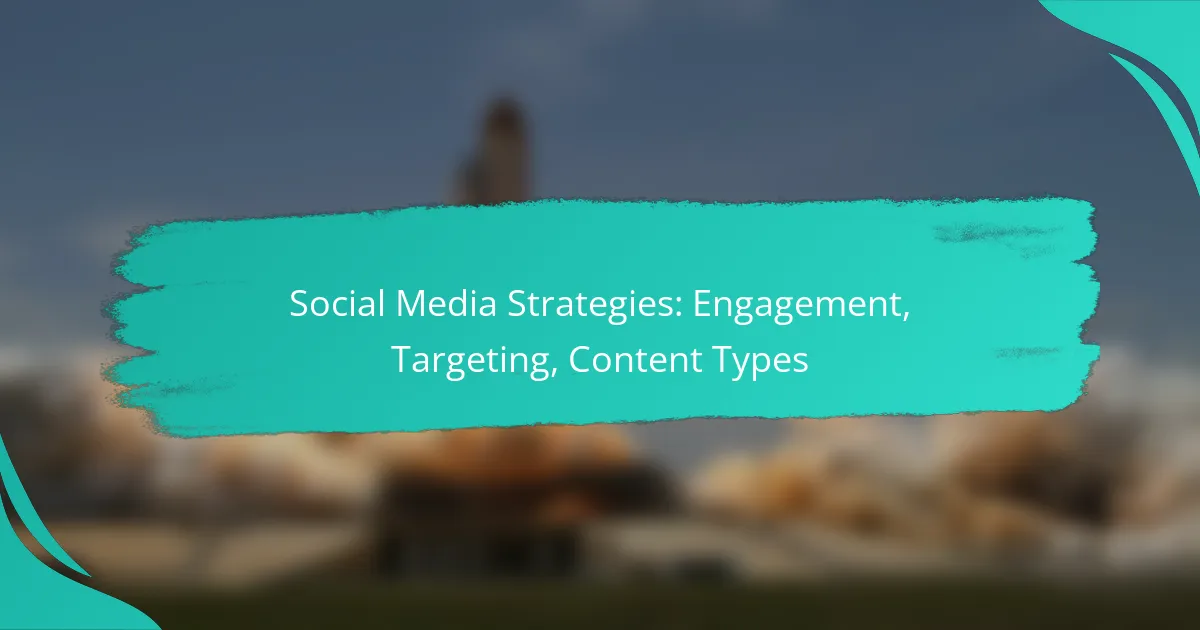In today’s digital landscape, developing effective social media strategies is crucial for fostering engagement and reaching target audiences. By focusing on content types that resonate with users, such as videos and infographics, and employing targeted approaches based on demographics and interests, brands can enhance their interactions and campaign success. Prioritizing meaningful connections with audiences will ultimately lead to improved engagement and a stronger online presence.

How to increase social media engagement in Canada?
To increase social media engagement in Canada, focus on creating meaningful interactions with your audience through various strategies. Prioritize content that resonates with Canadian users and encourages participation.
Utilize interactive content
Interactive content, such as polls, quizzes, and surveys, can significantly boost engagement. These formats invite users to participate actively rather than passively consuming information.
For example, a Canadian brand could create a quiz about local culture or current events, encouraging users to share their results. This not only increases engagement but also fosters a sense of community among participants.
Leverage user-generated content
User-generated content (UGC) is an effective way to enhance engagement by showcasing your audience’s creativity. Encourage your followers to share their experiences with your products or services, which can be featured on your social media channels.
Consider running a campaign that invites Canadians to post photos using a specific hashtag. This not only increases visibility but also builds trust, as potential customers see real people enjoying your offerings.
Implement contests and giveaways
Contests and giveaways are powerful tools for driving engagement. They create excitement and incentivize users to interact with your brand, often leading to increased visibility through shares and tags.
For instance, a Canadian company could host a giveaway where participants must like, comment, and share a post to enter. Ensure the prizes are appealing to your target audience to maximize participation.
Engage with comments and messages
Responding to comments and messages is crucial for fostering a sense of community and loyalty. Engaging directly with your audience shows that you value their input and encourages further interaction.
Make it a practice to reply to comments promptly and thoughtfully. Acknowledging both positive feedback and addressing concerns can enhance your brand’s reputation and encourage ongoing engagement from your followers.

What targeting strategies work best for Canadian audiences?
Effective targeting strategies for Canadian audiences include demographic, interest-based, and location-based approaches. These methods help marketers reach specific segments of the population, enhancing engagement and improving campaign outcomes.
Use demographic targeting
Demographic targeting focuses on characteristics such as age, gender, income, and education level. In Canada, understanding the demographics of your audience can significantly enhance your marketing efforts. For instance, targeting millennials with tailored content can yield better engagement rates compared to a one-size-fits-all approach.
Consider using platforms that allow you to filter audiences based on these demographics. Facebook and LinkedIn, for example, provide robust tools for narrowing down your target audience, ensuring your message reaches the right people.
Implement interest-based targeting
Interest-based targeting involves reaching users based on their hobbies, preferences, and online behavior. This strategy is particularly effective in Canada, where diverse interests can vary widely across regions. By analyzing user data, brands can create content that resonates with specific interests, such as outdoor activities or technology.
Utilizing social media platforms that offer interest-based targeting options, like Instagram and Pinterest, can help you connect with audiences who are more likely to engage with your content. Tailoring your messaging to align with these interests can lead to higher interaction rates.
Leverage location-based targeting
Location-based targeting allows marketers to reach audiences based on their geographic location. In Canada, this can be particularly useful for businesses that operate in specific provinces or cities. By using geotargeting, brands can deliver localized content and promotions that are relevant to the audience’s immediate environment.
Consider using tools like Google Ads or Facebook Ads to set up location targeting. This can help you optimize your campaigns for specific regions, ensuring that your marketing efforts are relevant and timely. Additionally, be aware of local events or cultural nuances that may influence your messaging in different areas.

What content types drive engagement on social media?
Content types that drive engagement on social media include video, infographics, live streams, and stories. Each type has unique characteristics that can capture audience attention and encourage interaction, making them essential for effective social media strategies.
Video content
Video content is one of the most engaging formats on social media, often resulting in higher shares and comments. Short, visually appealing videos that convey a message quickly tend to perform best, typically ranging from 15 to 60 seconds.
To maximize engagement, focus on creating content that is entertaining or informative. Consider using captions as many users watch videos without sound, and ensure your videos are optimized for mobile viewing.
Infographics
Infographics combine visuals and text to present information clearly and concisely, making them highly shareable. They are particularly effective for conveying complex data or statistics in an easily digestible format.
When creating infographics, use consistent branding and a clear layout. Aim for a balance of visuals and text, and ensure that the information is relevant to your audience’s interests to encourage sharing.
Live streams
Live streams provide real-time interaction, allowing brands to engage directly with their audience. This format fosters a sense of community and urgency, as viewers can ask questions and receive immediate responses.
To enhance engagement during live streams, promote the event in advance and encourage viewers to participate through comments. Keep the content dynamic and interactive to maintain viewer interest throughout the session.
Stories and ephemeral content
Stories and ephemeral content are temporary posts that disappear after a short period, typically 24 hours. This format encourages quick consumption and frequent engagement, as users often check back for updates.
Utilize stories to share behind-the-scenes content, polls, or quick updates. The fleeting nature of this content can create a sense of urgency, prompting users to engage before it disappears.

What are the best practices for social media content creation?
The best practices for social media content creation focus on engaging your audience, maintaining brand identity, and tailoring content to each platform. Effective strategies include consistent messaging, optimizing formats, and leveraging analytics to refine your approach.
Maintain brand consistency
Brand consistency is crucial for building trust and recognition across social media platforms. Ensure your visuals, tone, and messaging align with your overall brand identity, using the same color schemes, logos, and fonts in your posts.
To maintain consistency, create a style guide that outlines your brand voice and visual elements. This guide can help all team members produce content that reflects your brand accurately, regardless of the platform.
Optimize for each platform
Each social media platform has unique characteristics and audience preferences, making optimization essential. Tailor your content format, length, and style to fit the specific platform, such as using images for Instagram and text-focused posts for Twitter.
For example, Instagram thrives on high-quality visuals, while LinkedIn is better suited for professional articles and industry insights. Understanding these nuances can significantly enhance engagement and reach.
Use analytics for content strategy
Analytics play a vital role in shaping your content strategy by providing insights into audience behavior and preferences. Regularly review metrics such as engagement rates, reach, and click-through rates to identify what works and what doesn’t.
Utilize tools like Google Analytics or platform-specific insights to track performance. Adjust your content strategy based on these findings, focusing on high-performing content types and optimizing underperforming ones to improve overall effectiveness.

How to measure the effectiveness of social media strategies?
Measuring the effectiveness of social media strategies involves evaluating various metrics that reflect audience engagement, conversion success, and overall growth. By focusing on these key areas, businesses can gain insights into their social media performance and make informed adjustments.
Track engagement metrics
Engagement metrics include likes, shares, comments, and overall interactions with your content. These indicators help assess how well your audience connects with your posts. Aim for a mix of high engagement rates, typically between 1% to 5%, depending on your industry.
To track these metrics effectively, use social media analytics tools that provide detailed reports. Regularly review these metrics to identify which types of content resonate most with your audience, allowing you to refine your strategy accordingly.
Analyze conversion rates
Conversion rates measure how many users take a desired action after engaging with your social media content, such as making a purchase or signing up for a newsletter. A good conversion rate varies by industry but generally falls between 2% to 5% for social media campaigns.
To analyze conversion rates, set clear goals for each campaign and use tracking tools like UTM parameters to monitor traffic sources. This data will help you understand which platforms and content types drive the most conversions, enabling you to allocate resources more effectively.
Monitor audience growth
Audience growth reflects the increase in followers or subscribers over time, indicating the effectiveness of your outreach efforts. A steady growth rate of 5% to 10% monthly is often considered healthy for social media accounts.
To monitor this growth, regularly check your follower counts and analyze trends over time. Identify any spikes or drops in growth and correlate them with specific campaigns or content types to understand what influences your audience’s interest.

What frameworks can guide social media strategy development?
Frameworks for social media strategy development provide structured approaches to enhance engagement, targeting, and content types. Utilizing established models can streamline the planning process and ensure alignment with business goals.
SMART Goals
The SMART framework emphasizes setting Specific, Measurable, Achievable, Relevant, and Time-bound goals for social media initiatives. For instance, rather than aiming for “more followers,” a SMART goal would be “gain 500 new followers on Instagram in the next three months.” This clarity helps track progress and adjust strategies as needed.
When implementing SMART goals, consider the resources available and the overall business objectives. Regularly review and adjust these goals to reflect changing market conditions or audience preferences.
Content Marketing Funnel
The Content Marketing Funnel outlines the journey from awareness to conversion, guiding content creation for different audience stages. At the top, focus on awareness through engaging posts and videos; in the middle, provide informative content like blogs or webinars; and at the bottom, use case studies or testimonials to drive conversions.
Each stage requires tailored content types and messaging. For example, a brand might use eye-catching infographics for awareness and detailed product demos for conversion. Understanding where your audience is in the funnel helps in crafting effective content.
Audience Segmentation
Audience segmentation involves dividing your target market into distinct groups based on demographics, interests, or behaviors. This approach allows for more personalized content, which can significantly enhance engagement rates. For example, a fitness brand might target young adults with high-energy workout videos while offering nutrition tips to older adults.
Utilize analytics tools to gather data on your audience and refine segments over time. Regularly revisiting your segmentation strategy ensures it remains relevant and effective in meeting the needs of your audience.
Engagement Metrics
Engagement metrics are crucial for assessing the effectiveness of social media strategies. Key metrics include likes, shares, comments, and click-through rates. Monitoring these metrics helps identify what content resonates with your audience and informs future strategies.
Establish benchmarks based on industry standards and your previous performance to gauge success. Regularly analyze these metrics to adapt your content strategy and improve overall engagement.
